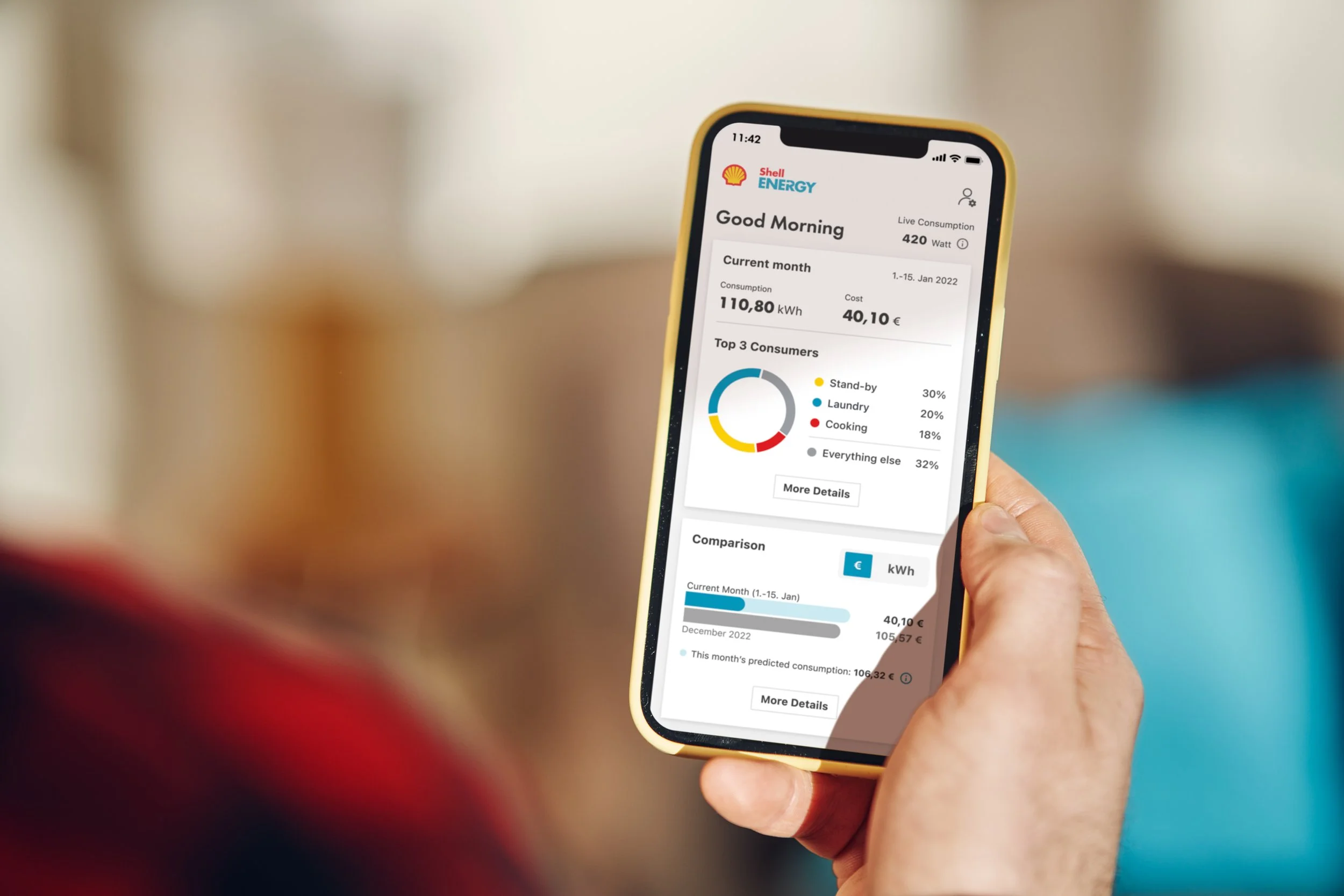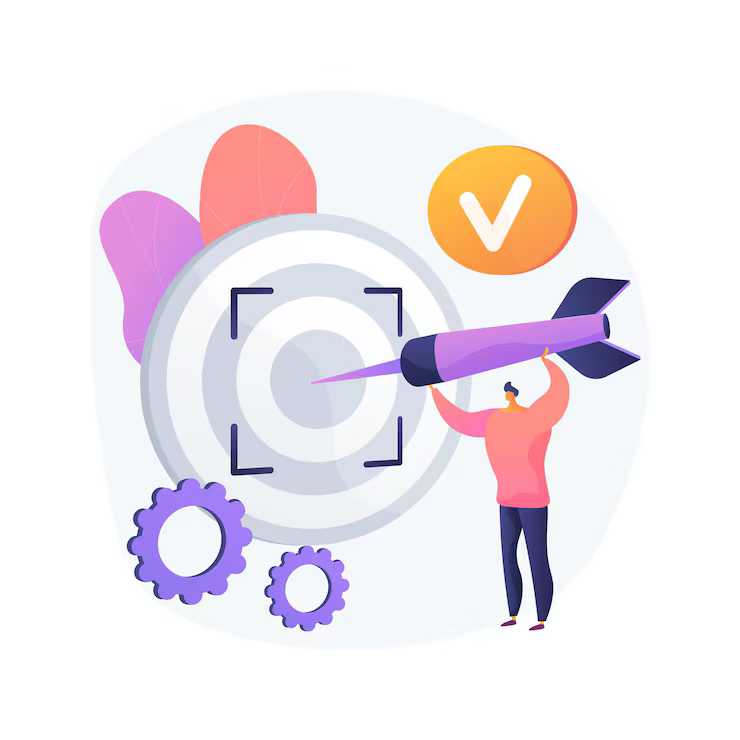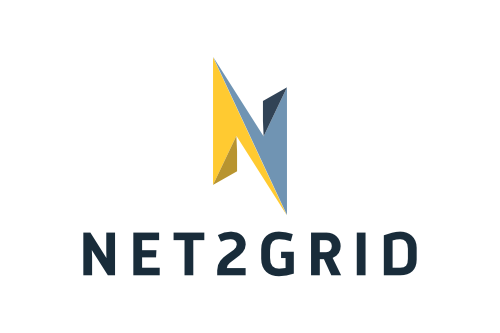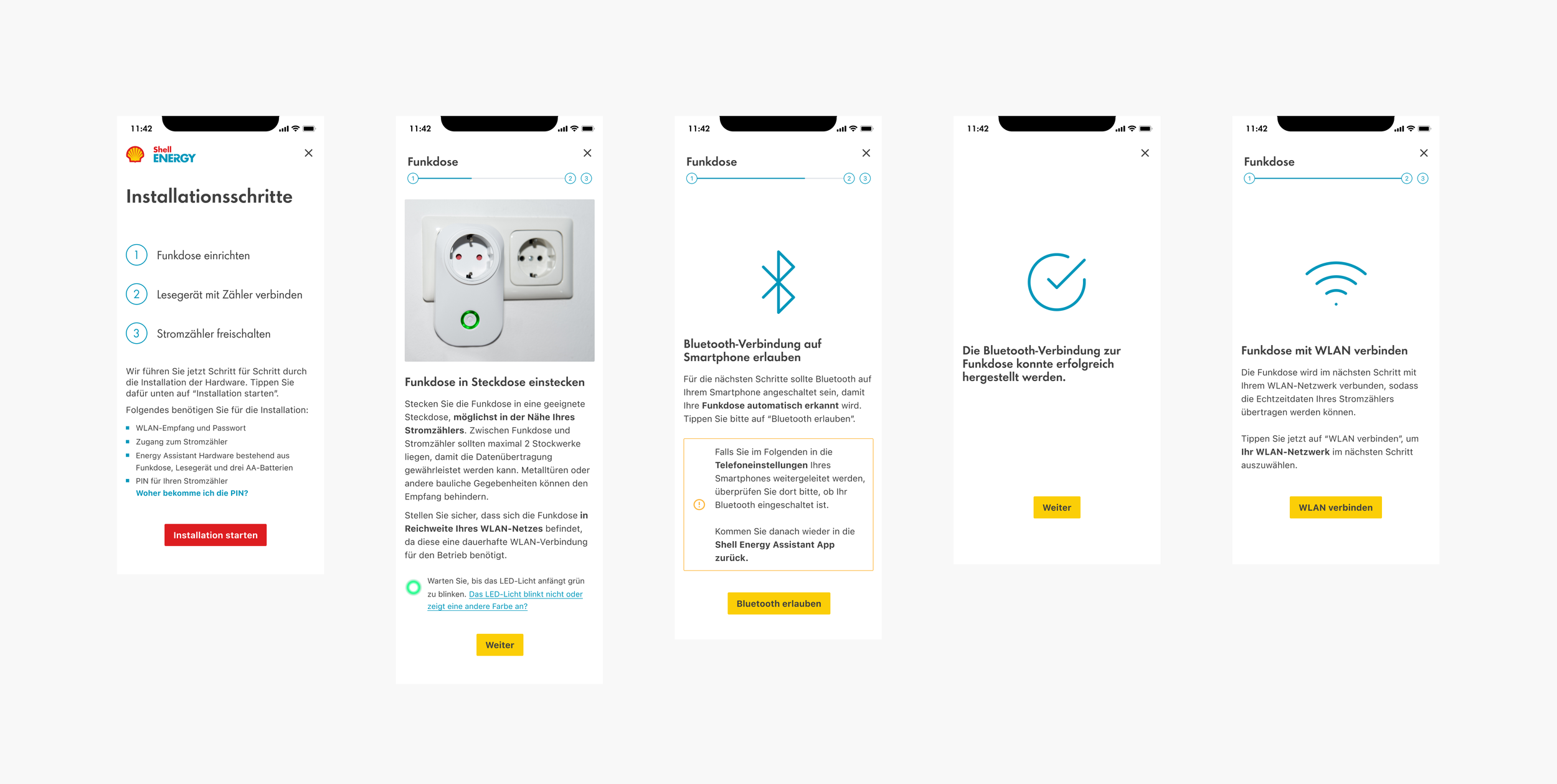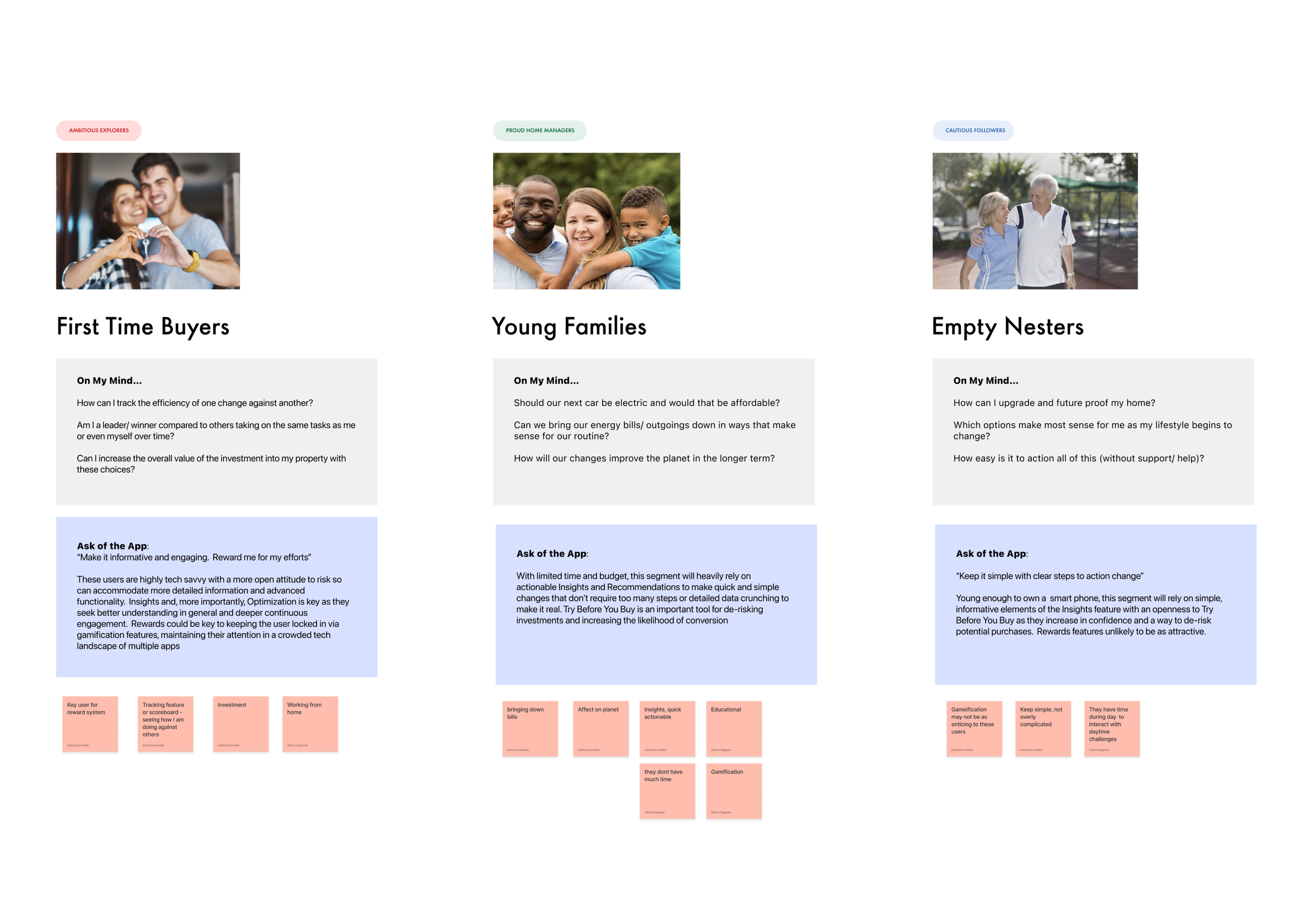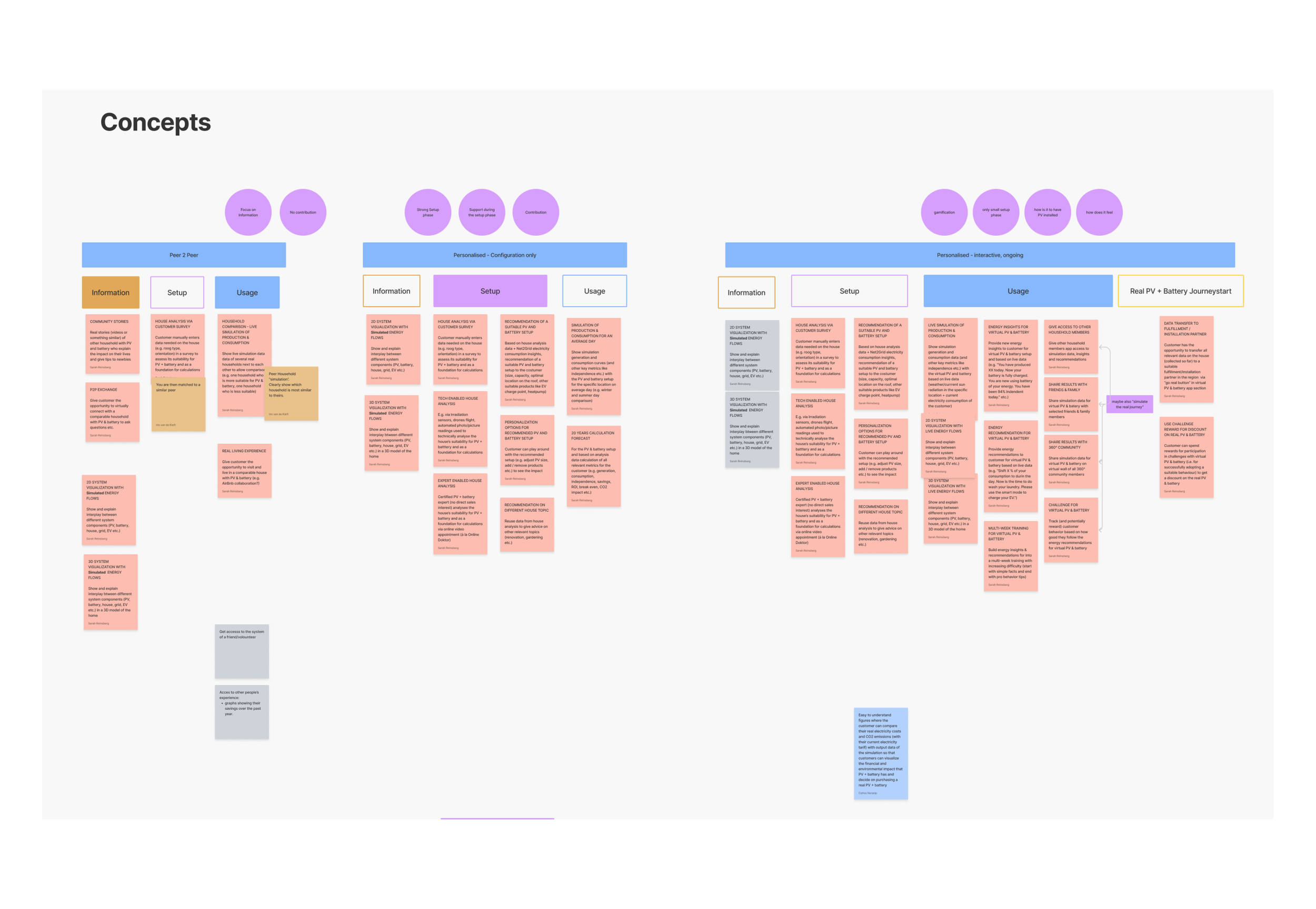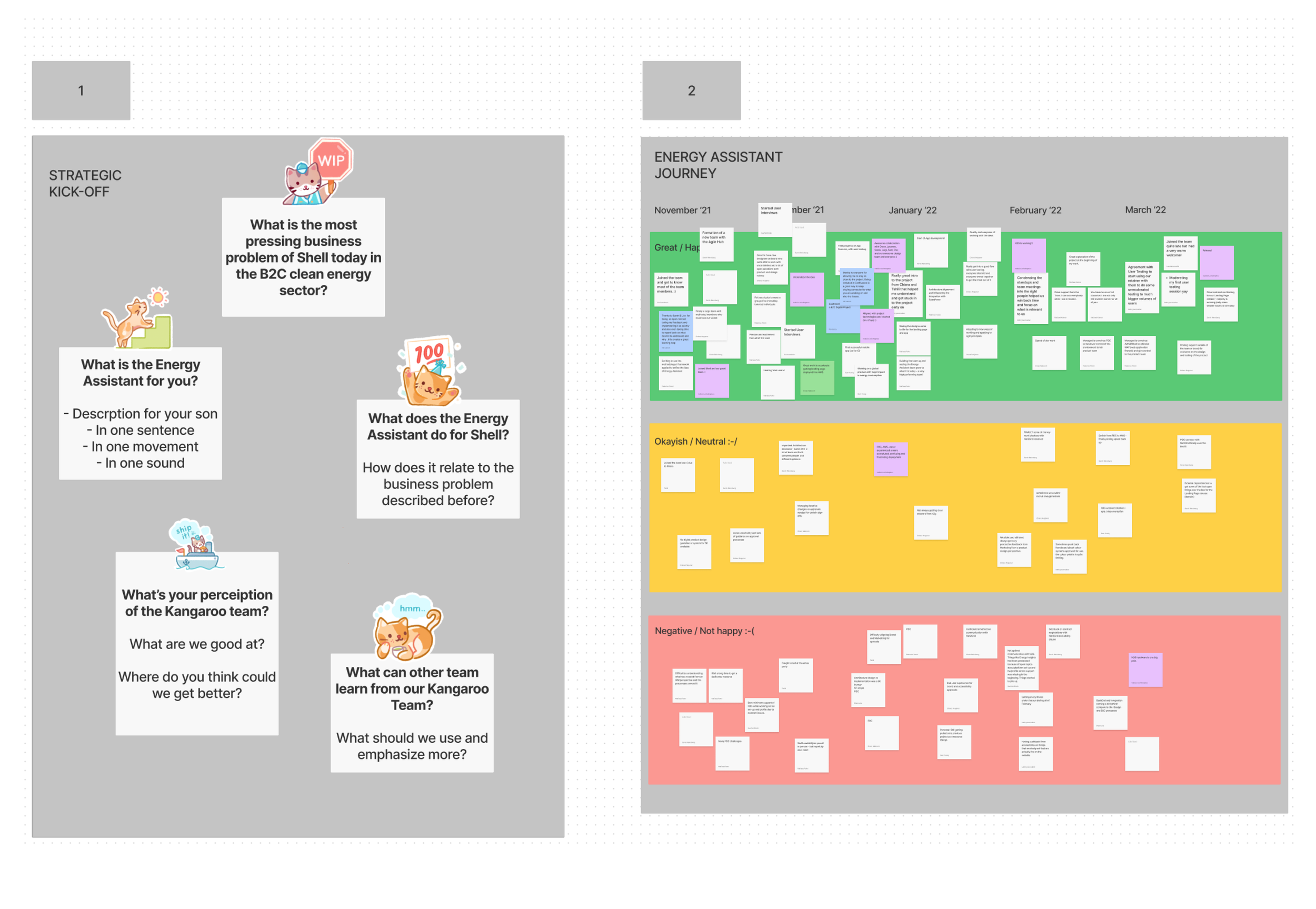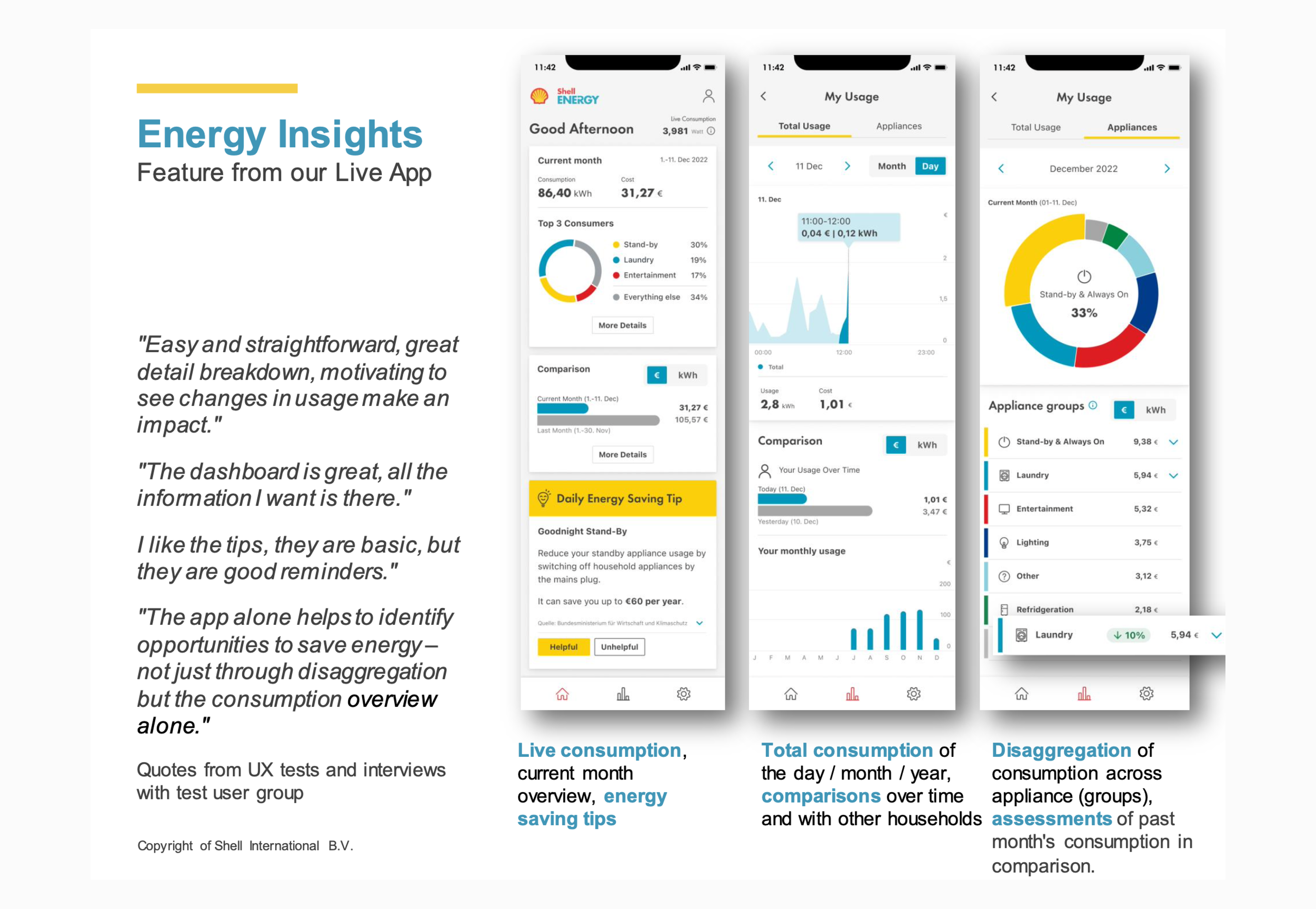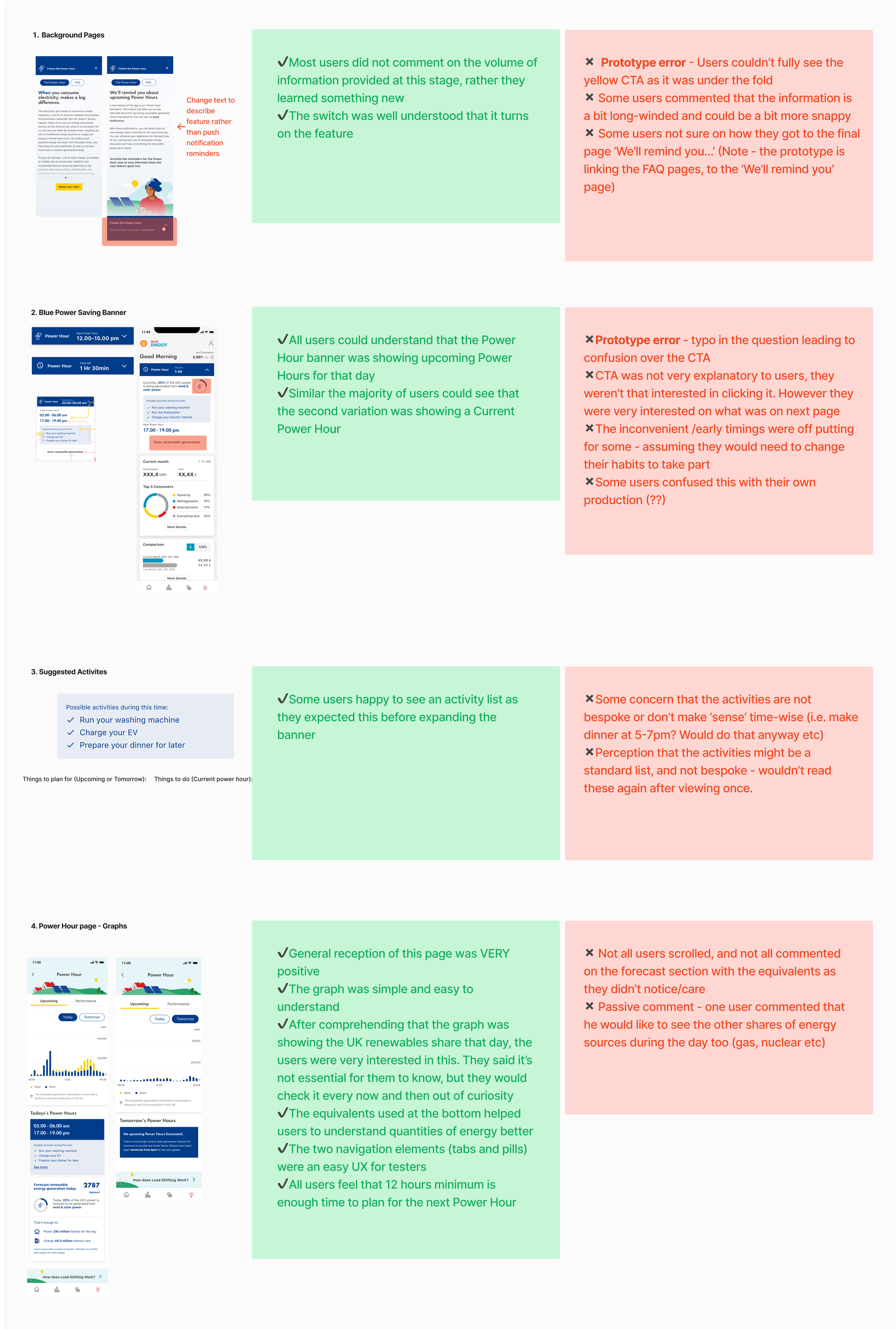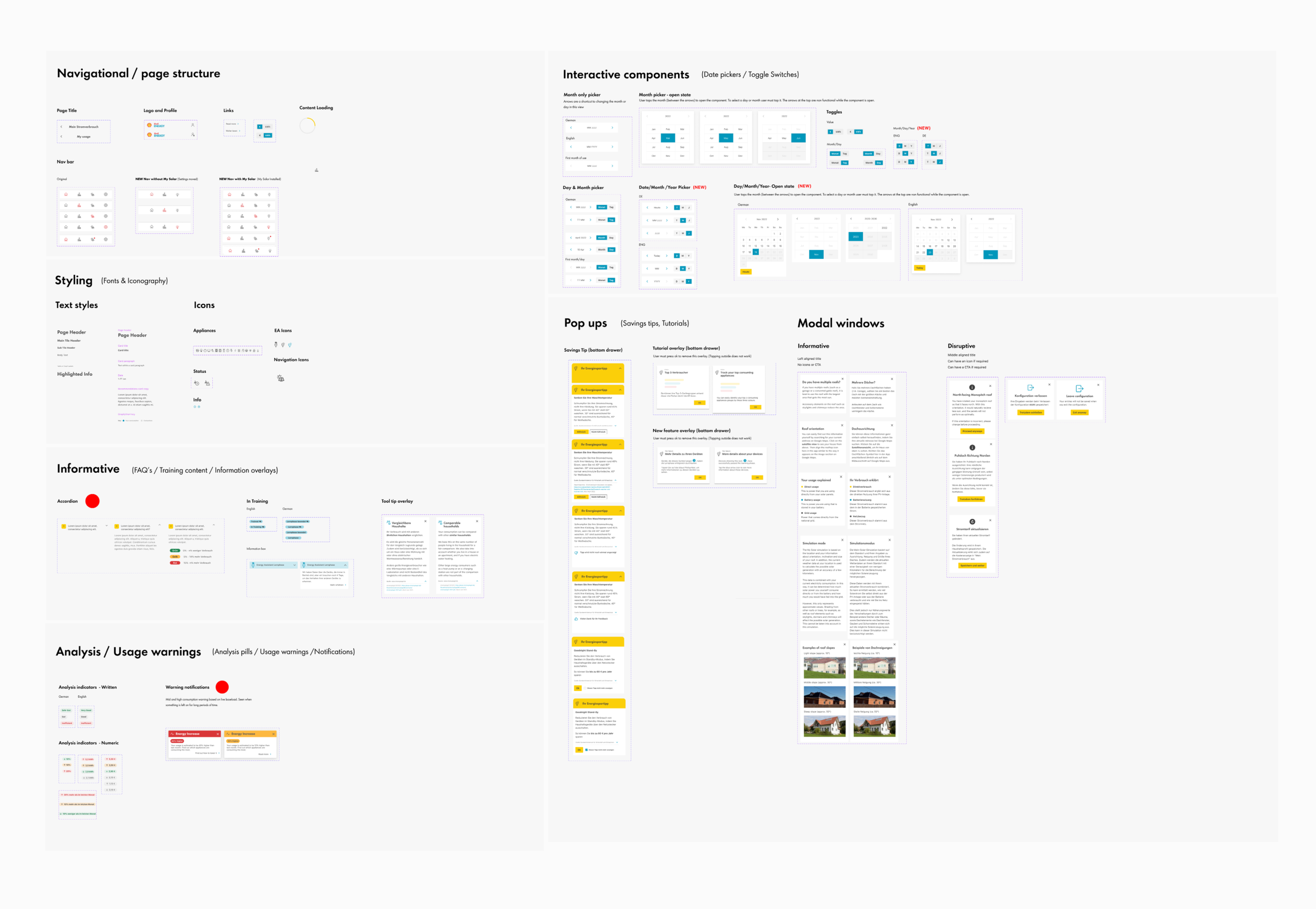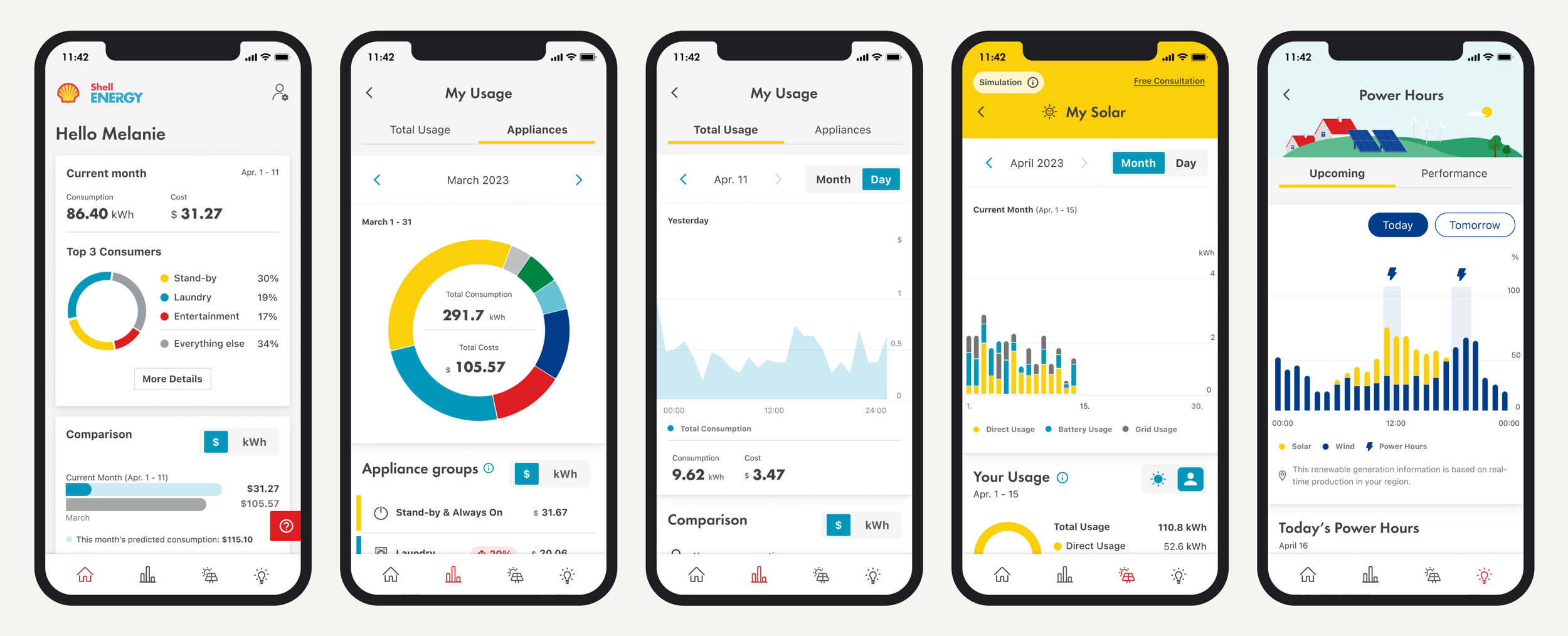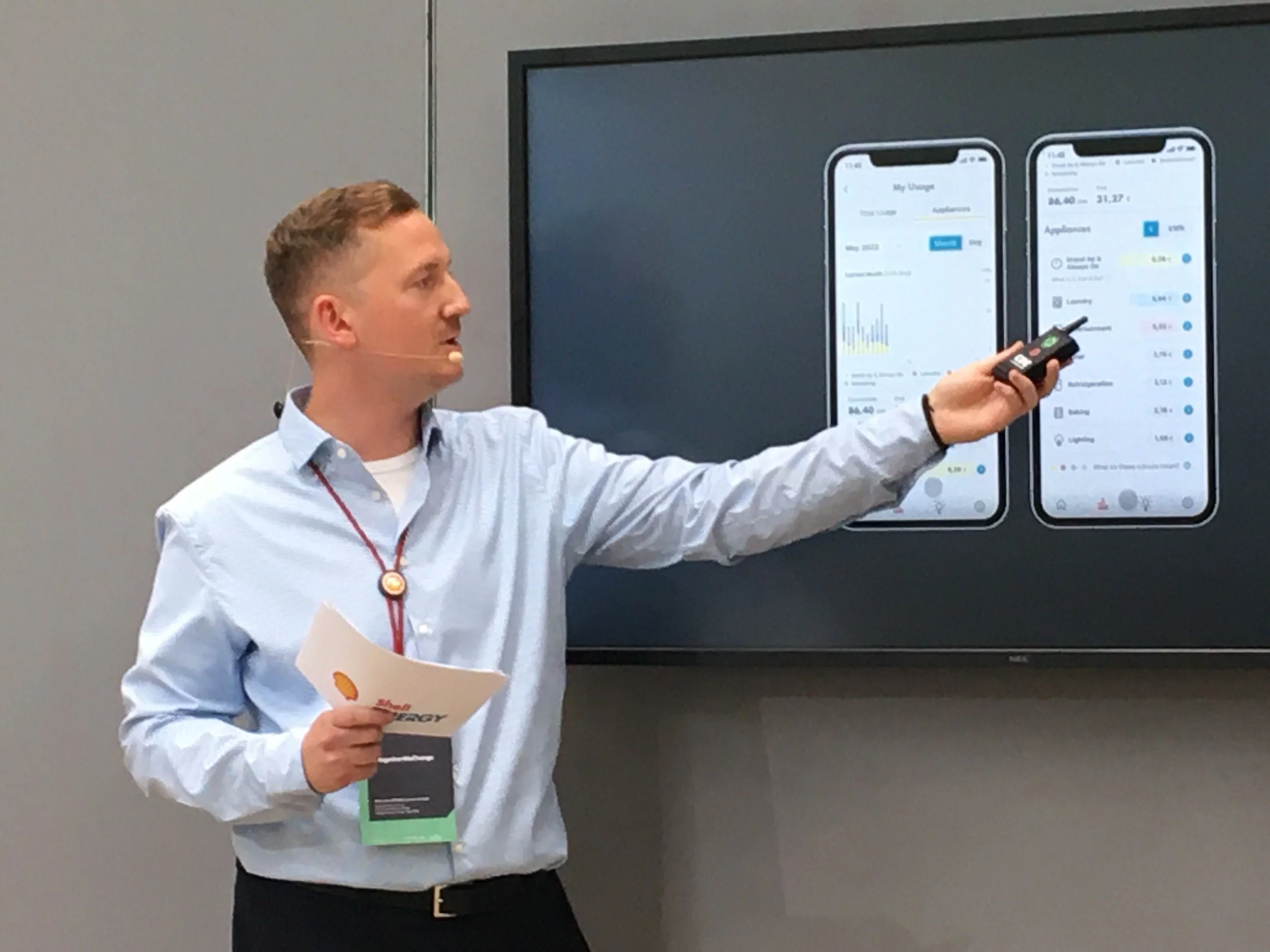2022
Proof of Concept - Full App Design and Build
Shell Energy Assistant
Client
Working in house directly for Shell.
Time
18 months
Activities
UI, UX, Wireframes, Conceptual Design, Prototyping, User Testing, Analytics, Workshops
Team
3 Product Designers, Technical Lead, 4 Developers, 2 Product Leads, Business stakeholders, 3 Business Analysts
Background
I was very excited to work on this project in the consumer energy space which was really changing in 2022. The end product is a consumer facing app that guides consumers to understand and activate potentials for cleaner & more efficient energy at home.
As the foundational features needed for the app had been defined (which I will outline later), my responsibility was to work on each of these features and create an attractive and easy to use app, that would resonate with consumers and offer them an engaging way to manage their household energy usage, beyond just reviewing their monthly bills.
This app was a test product for the German market for 100 Shell Energy Customers. The app was created fully in German so I needed to exercise my German linguistic skills to be able to create these flows and test across different locations too.
Exploring the consumer energy landscape
A large amount of research went into what the solution should be for the ‘energy customer of the future’. This research was conducted by the research and innovation team in Germany prior to my joining the team for this project. Some of the key insights that fed into the product vision are outlined below.
“‘Consumers have higher expectations from their energy provider - wanting more personalised solutions and simple end-to end experiences for more engagement’ ”
“Users have gone from more ‘passive consumption’, to having a growing interest and more active participation in the adoption of new energy solutions”
“A digital first approach is the preferred way by consumers to receive their consumption information”
The Product Vision
A new consumer mobile app for Shell Energy
'See your energy consumption in a new light. Discover your energy potential and track your impact.‘
✅ Value for the business
Reduction of high bill calls and churn due to improved CX
Targeting of customers and customisation of offers based on real data
✅ Value for the customer
Transparency and control of energy consumption and costs
Starting with the basics, we needed to first understand technical requirements
In order to collect the consumption data from consumers, we needed to work very closely with a third party provider. The provider was able to provide load-disaggregation technology and accompanying hardware. The hardware allows the Energy Assistant to app to display the household consumption data of not only the overall usage, but also broken down by individual appliance.
The data that we could have access to once this setup process had been complete, was extremely complex and detailed. Myself and 2 other designers had the job of condensing down what data could be used, and how it could be displayed to the customer, without overwhelming or confusing them.
The hardware and software connection was a real time-consumer
We spent many weeks on workshops with the third party provider to iron-out the technical capability and how they would translate into features for the users. This involved creating the setup process for the user on the app, and the user being required to install the hardware physically in their home.
Once the hardware was up and running, the app features were scoped
There are four key features for the app, each of these we spent approx a quarter of a year testing and refining designs, and gradually releasing them to ours users.
⭐ Feature 1: Energy insights
The key feature of the app was to be able to provide real-time data for a user’s household, both on a total and an appliance-level. This is to provide trust, transparency & control.
⭐ Feature 3: Challenges & rewards
An engagement feature that would motivate continued usage of the app, with potential rewards to recognise positive behaviour changes.
⭐ Feature 2: Product recommendations with try-before-buy services
This is a simulation engine using real data that would give users a chance to try out products such as solar panels, helping to provide decision guidance before a big purchase.
⭐ Feature 4: Advanced smart controls in home
(Out of scope)
Bringing a vision to reality
Research
Before I started with this project team, a research and innovation team located in Shell Energy Germany had already conducted six months' worth of research and exploration to arrive at the concept of developing a consumer-facing app to achieve the business objectives of this initiative.
Some of this work included building out the personas. We needed to make sure that the app appealed across the spectrum of these groups as some of the demographics very different in terms of age and interests.
For features of the app such as engagement, we conduced large amounts of research into gamification systems, which included psychology white papers and lots of competitor analysis.
It was also important to get an idea of the full online/offline experience, as this would be vital in ensuring that users could successfully set up their account and stay informed about product updates. We kept track of this by using customer journey maps.
Designing a PoC for testing
The screens iterated and evolved over the course of testing. Here are a few examples of the screens and journeys tested.
Users testing was crucial to improving the features
User testing was conducted almost weekly by the design team. We set up qualitative interviews both moderated and unmoderated, and manage to validate most features and designs thoroughly before going any further into development. Some examples of our testing practices can be seen below.
Testing outcomes showed interesting results. We would find different users would have certain preferences to how they want to view data, for example seeing their usage in kWh vs Euros. We also had an important job to do in terms of making sure that complex data was understood graphically with simple bar graphs and donut charts to make this more digestible.
Collaborating for success
Frequent workshops
As well as testing, we frequently conducted workshops with the wider teams, to ensure that features were scoped from a functionality as well as technical feasibility perspective from the very beginning. This ensure we didn’t go off on a tangent and kept the team working closely together. We also found engineer and product inputs and ideas in the early concept stage to be invaluable and promoted a collaborative working practice in the team with shared Figjam files, and co-working spaces.
Managing designs
Our design files were large and needed to be accessible by all of our stakeholders, from marketing teams to engineers. We had created a good way to collaborate on the files whilst always keeping them up to date, with recent changes from new iterations and any comments from stakeholders.
Working closely with the Shell Energy Marketing team and using only a Shell Design system as guidance, we created a full design system for this new app from scratch, with new bespoke components and a style that was aligned to the Shell Energy brand.
Final Outcome
The app was in use by around 50 German Shell Energy customers for about a year. In this time, we received valuable feedback about its usability, and the features. Overall, the users really loved the app and found it gave them very insightful data about their home energy usage and encouraged them to make changes to improve their energy efficiency. One user even invested in a new fridge after seeing how much an older energy inefficient model was costing him every month.
The app was showcased at the Greentech Festival in Berlin., but sadly not launched to the market due to the closure of the Shell Energy business in the planned launch regions.


